An Overview of the Pipe Organ
Every Organ Is Unique
Each pipe organ has been individually crafted for the customer. Picture
yourself going to a tailor where not only is your suit custom made, but
the fabric is custom woven as well. The quality-oriented builder works
with the customer's needs and wants to produce the best organ that the
budget can allow. The architecture and acoustics of the room are factored
into the organ's design. The different sounds are chosen together by the
builder and the customer.

When you look at the instrument, you can notice immediately if it is
a free-standing organ or a built-in instrument. A free standing instrument
has a case that is built to house all the pipes and parts that make the
organ work. This picture of the new Dobson instrument at the University
of South Carolina is an excellent example of a free-standing organ. The
case acts as a sounding board to focus and project the sound, much like
the wood of a violin or guitar.
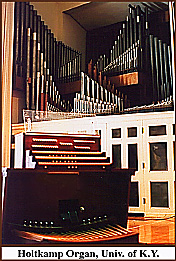
A built-in instrument is literally attached to the building. In the
picture of the Holtkamp, you can see that there is no case around the organ.
The screened doors on the bottom half are hiding the motor and parts that
supply wind to the pipes. There are also some pipes behind these screen
doors. The Schantz is typical of a church organ. The motor and wind supply
parts are in other parts of the church. The blower, which supplies the
wind, is in the basement. Pipes line the chancel with more pipes in chambers
on the left and the right, behind the vertical wooden blinds on the side
edges of this picture.
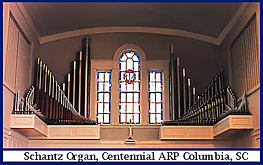
Swell Shades and Pipe Screens
What are these wooden blinds? These are shutters or shades. Because
they are always found covering the part of the organ called the swell,
they are often called swell shades. However, they can be placed in front
of the Choir and Solo divisions. They
are strictly functional. When the shades are closed, the sound from the
pipes can't get out so it will be fairly soft. As the organist opens the
shades, the sound gets louder.
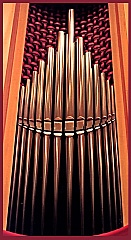 Swell shades are not to be confused with pipe screens, which are purely
cosmetic. In the picture of the Dobson, you can only see the pipes in the
front row. All gaps are filled in by the red lattice. This lattice, together
with this first row of pipes, is the pipe screen. Although you can't see
behind the screen, the sound can still get out. The pipe screen is useful
when the builder wants to hide the other parts of the organ which are not
as attractive as the pipes.
Swell shades are not to be confused with pipe screens, which are purely
cosmetic. In the picture of the Dobson, you can only see the pipes in the
front row. All gaps are filled in by the red lattice. This lattice, together
with this first row of pipes, is the pipe screen. Although you can't see
behind the screen, the sound can still get out. The pipe screen is useful
when the builder wants to hide the other parts of the organ which are not
as attractive as the pipes.
Many different materials for pipe screens have been used. Most builders
use wood carvings or metal shaped into intricate patterns. I have even
seen cloth but that is not a good screen because it muffles the sound.
The pipe screen is there to make the organ attractive, not detract from
the sound. The Dobson pipe screens are unique because they are pieces of
painted PVC pipe with wood joining them together on the backs of the pieces.
Pipe screens often use the first row of pipes, artistically arranged,
as part of the screen. However, some builders will not use the front pipes
to hide others and will put a large screen in front of the whole organ.
The instrument in First Scots Presbyterian Church in Charleston, built
by Ontko and Young, has a large, beautiful, white wrought-iron decorative
screen. In many organs, including the Dobson example, these pipes are part
of the organ and will speak.
In some older organs from previous centuries, small pipes were used to
fill in the gaps. These were fake pipes because they did not speak. In
the 1800s, it was common to have the front row make of speaking pipes but
to paint decorative designs on the pipes. The paint does not affect the
sound. Today, most builders prefer to polish the pipes.
During this century, a push to expose the organ took place. One builder,
Holtkamp of Cleveland, did not use pipe screens but arranged his pipes
asymmetrically. He also put the swell shades in full view of the audience.
He felt it would be more exciting if the audience could see the organist
open the shades and hear the music getting louder simultaneously. The picture
of the Schantz also does not have any pipe screens.
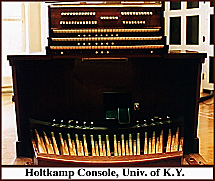
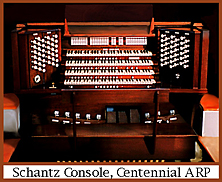
The Console
In the picture of UK's Holtkamp, you can see that the manuals
and pedals are some distance away from the actual organ. The entire unit,
keys, buttons, knobs and all, is called the console. It has everything
the organist needs to control the organ. This one can be moved around the
stage. Organs can also have an attached, non-movable console, which the
Dobson has. The manuals usually have 61 notes, 30 less than a piano. The
pedals duplicate the bottom 32 notes of the manuals but have their own
sounds, separate from the sounds of the manuals. The different kinds of
sounds available are called the stops. On the Holtkamp, they are the tabs
above the manuals. On the picture of the Schantz console, they are the
drawknobs on the left and right of the console.
Now that you are more familiar with the organ, you may want to learn
how the sound is produced.
This site is part of the Pipe Organ Education Project.
© Copyright 1996-2001 by Marya J. Fancey.